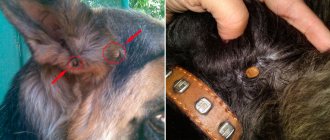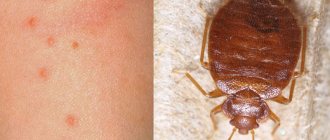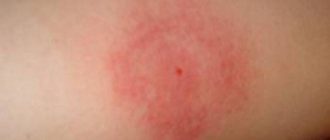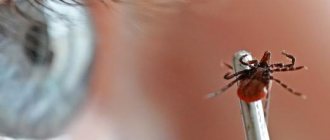The topic of ticks and the diseases they carry becomes especially relevant in the spring! The time from the end of April is a hot time of concern for pet owners. Let's figure out what kind of animal this is - a tick, how to prevent an animal from becoming infected with a tick, and what to do if your animal is bitten.
A tick bite, or rather the disease that infects the victim as a result, is usually dangerous for dogs, since they more often end up in the habitat of this insect. It is very important to take action in time and, most importantly, as quickly as possible, otherwise a dog bitten by a tick may not be saved. A fatal outcome for a dog that has been bitten by a tick is a very common occurrence in our lives. In addition to reacting to what has already happened, it is also important to take preventive measures!
Insect - mite. What does a tick look like?
Ticks (lat. Acari, Acarina) are a subclass of arthropods from the class of arachnids. This group is the largest in the class: over 48 thousand species are currently described! There is even a branch of zoology that studies ticks, called acarology. The length of ticks is usually 0.2-0.4 mm, but can reach 5 mm. The body is whole or divided into two parts, where the cephalothorax is smaller than the abdomen. There are usually 6 pairs of appendages, of which 4 posterior pairs in most adults are legs (larvae usually have 6 legs), and another pair is included in the complex of oral organs. Representatives of some families of ticks have a soft body, with leathery chitinous coverings, while others may be protected by hard shields or a shell.
Not all ticks are parasites. Most species are free-living saprophages or predators. They feed on decaying organic matter, and together with earthworms, play an important role in the formation of soil humus. Some types of mites are classified as agricultural pests because they feed on plant sap.
In some families of ticks, the phenomenon of omovampirism occurs, when a hungry individual attacks a well-fed “fellow” and feeds on the blood it drinks. Ticks can live in grass and low plants, as well as on various trees.
Ticks carry various viruses and microbes that provoke a number of diseases: sarcoptic mange, otodectosis, cheyletiellosis, demodicosis, very dangerous and common - piroplasmosis, encephalitis, and others.
Autumn walk in the forest and park
It's rare that a dog owner doesn't use protective sprays, drops, tablets, collars or ultrasonic repellers. The dog’s life depends on their quality and effectiveness of the active substance. And it’s better for people to treat their clothes before going for a walk not only in the forest, but also in the park, before going to the country, etc. There have indeed been more ticks, and their distribution area has expanded. It is impossible to completely isolate an animal from ticks that wait for their prey at training grounds, stadiums and on the sides of city paths. Article on the topic: “Bloodsucking ticks attack the Moscow region.” I advise you to look at this article, because... it describes in detail the means of protecting people from this parasite, and names the first actions in case of its bite.
So, the first wave of ixodid tick activity occurs from the beginning of May to the end of June. The second is from August to the end of October - beginning of November. In the intermediate periods, the likelihood of a tick bite only decreases.
What types of ticks are dangerous for dogs, cats and other types of pets?
First of all, it is important to know that any types of ticks that live on the body of an animal or a person, whether they drink blood or feed on the skin, are parasites. And you need to get rid of them as quickly as possible. The most common:
- Blood-sucking ticks
- Subcutaneous mites
- Ear mites
In the spring-summer period, the most dangerous ixodid ticks are: Ixodes ricinus and Ixodes persulcatus. These types of ticks are blood-sucking and carry many dangerous diseases. Of course, not every tick is a carrier of the disease, but there is always a threat of infection! In addition to humans, the victims of these ticks are more often dogs, less often cats. Since the principle of infection and treatment is the same, let’s talk about ticks using the example of ticks on dogs . Pets that only walk in the yard are also at risk! Blood-sucking mites can also live in city flower beds. Moreover, “urban” ticks carry dangerous diseases more often.
Ixodid and Argasid ticks (blood-sucking)
These types of ticks live mainly in grass and low bushes, and not in trees, as many people believe. That is, they usually land on the dog’s body from below. They attach themselves to the least hairy areas of the body if they can reach them, but they can also crawl under the fur. Most often, ticks attach themselves to the following parts of the dog’s body:
- paws, incl. between the fingers,
- breast,
- belly, armpits,
- ears,
- folds of skin,
- neck from the bottom.
Unlike other parasitic mites, these do not live on the donor’s body permanently, but attach themselves only temporarily to feed. The size of a hungry tick is about 3 mm; as it becomes saturated, it fills with blood and increases in size, swelling. The color is dark, from gray to almost black, and brown shades; a engorged tick is lighter. The tick's body is flat (when hungry), oval. As the insect fills with blood, it becomes like a leathery pea.
The tick is “screwed” into the body of an animal or person clockwise, which is facilitated by the screw structure of its oral apparatus. It takes a long time to screw in, making up to 30 turns.
What diseases can they cause?
Tick bites are harmless to dogs and are painless. After a bite, the dog is bothered by severe itching, burning, and swelling at the site of the injury. But blood-sucking insects can be infected and often carry serious diseases that are dangerous not only to the health, but also to the life of the pet.
Why ticks are dangerous for dogs:
- piroplasmosis;
- borreliosis;
- ehrlichiosis;
- hepatozoonosis;
- bartonellosis.
Piroplasmosis is one of the most common canine diseases. Its causative agent is a separate type of parasite, the encephalitis tick, which secretes toxic substances that destroy red blood cells.
The disease is accompanied by a deterioration in the dog's appetite, increased thirst, bloody diarrhea, shortness of breath, increased body temperature and dark colored urine. The dog becomes lethargic, apathetic, and does not respond to commands. Treatment is difficult and lengthy, and in later stages it is unsuccessful.
Piroplasmosis does not pose a danger to humans.
Borreliosis develops due to infection with Borrelia bacteria. The first signs of pathology can be noticed 15–20 days after a tick bite. The pet's gait is disturbed, he has a fever, heart problems, pathologies of the joints, kidneys, weakness, and lethargy. You may notice enlarged lymph nodes. Borreliosis is dangerous for people and causes the development of Lyme disease.
Peak tick activity
Ehrlichiosis - the causative agents are infectious agents Ehrlichia, which penetrate into cells and disrupt their structure.
Symptoms of the disease: convulsions, severe joint pain, fever, enlarged spleen and liver, inflammation of the eyelids and frequent hemorrhages in the eyeballs.
The dog suffers from debilitating nosebleeds, shortness of breath, weakness and apathy. In severe forms of ehrlichiosis, pathologies of the liver and kidneys, lesions of the brain and bone marrow develop. Some types of these infectious agents are dangerous to humans.
Hepatozoonosis is a parasitic infection that continues with an intense decrease in immunity, which can last for several years. The main signs are watery or purulent discharge from the eyes, painful spasms in muscle tissues and joints, weakness, and depression. Hepatozoonosis is not transmitted to humans.
Bortonellosis is a disease that poses a serious danger to animals. The first signs of the disease can appear either after a few weeks or after several years. This is a deterioration in the motor activity of the hind legs, inflammation of the joints, attacks of fever, hemorrhages in the eyes, anemia, loss of strength, drowsiness and apathy.
The pet is rapidly losing weight. Bortonellosis can cause pulmonary edema, meningitis and even sudden cardiac arrest. Certain types of these pathogens are dangerous to people. If a dog is bitten by an infected tick and is not promptly treated, the disease may become chronic.
In such cases, irreversible pathological changes occur in the most important internal organs: the heart, circulatory system, joints, liver and kidneys. The consequences of a tick bite on a dog can be dire, even fatal. At the first change in the behavior of a pet, the owner needs to immediately show the dog to a veterinarian.
Using aerosols and other tick repellents will help protect your pet's health.
The doctor will prescribe all the necessary examinations, including a PCR blood test, which will allow the specialist to accurately assess the situation and make a diagnosis. Timely treatment will help save the life of your pet.
Detection of ticks on a dog and removal of ticks from the animal’s body
Once again, it is important to remove the tick and take measures to diagnose and treat a possible infection as quickly as possible. Every day, and sometimes even hourly, you risk losing your pet.
After your dog is outside, you need to carefully examine it. It is better to wear rubber gloves (since the virus can penetrate with the insect’s saliva through microcracks in the skin). Feel your dog, starting with the most common areas described above. It is very easy to feel a tick with your fingers, especially if it has already sucked blood. For particularly fluffy dogs, use a flashlight.
The tick may appear as a pimple, mole or wart on the dog's body, don't miss it. During mid-spring and early summer, ticks are most active. So it is better to examine the dog at least a couple of times a day. If you find a tick, either remove it yourself or go straight to the vet. The second is necessary in any case, in order to get the dog tested and take preventive or therapeutic measures according to the situation.
The dog himself can signal that he has been bitten by a tick, but symptoms appear if an infection has occurred. The dog becomes lethargic, tends to hide in a corner, loses appetite, body temperature rises, the nose becomes hot and dry... Symptoms may vary for different diseases carried by ticks, but in any case you need to immediately take your pet to the hospital.
How to remove a tick from a dog's body
- To grab a tick, it is better to use tweezers, grabbing the tick closer to the head. But if you don’t have tweezers, you can use a thread to make a loop; it’s important to drape it “around the tick’s neck.” Special plastic devices for this purpose are also now sold.
- It is important not to tear off the tick's head, which will remain under the skin, and not to press on the tick's body. Because even if
the insect is a carrier of the disease; dangerous bacteria and viruses may not yet have entered the dog’s blood. - Begin to slowly and steadily pull out the tick. This may take 15-20 minutes - this is normal! Some veterinarians advise twisting the tick. Do this as carefully as possible, slowly, counterclockwise! If you are not confident in your abilities, it is better to just hold out. It is important to remember the danger of crushing a tick.
- A piece of the dog's skin may come off along with the tick - this is also normal. don't be scared. Most likely, when you pull the insect out, a drop of blood will appear; lightly press on the edges of the wound so that the blood comes out.
- Do not throw away the tick after you have removed it. If the dog shows signs of infection, it should be taken to the veterinarian for analysis and to simplify the diagnosis.
- If part of the tick still remains in the dog’s body, you need to carefully remove it with tweezers. If that doesn't work, contact your veterinarian.
- Lubricate the wound left after removing the tick with brilliant green or iodine. Check the affected area for several days; if irritation appears or the wound does not heal for a long time, contact your veterinarian!
- As a folk method, vegetable oil, or Vaseline, as well as all sorts of chemicals are often used to make the tick suffocate and make it easier to pull it out. We do not recommend doing this (even using oil). Since the tick can release all the liquid from itself into the dog’s body, and all kinds of chemicals are harmful to the animal.
- The tick itself will detach itself from the wound only when it has had enough. You shouldn’t wait for this moment and let everything take its course.
Help your pet
What to do if there is a tick on your dog? When an owner walks an animal outside, there is a high risk of picking up a tick. If a tick is spotted on a dog, the procedure for removing it is simple. Everyone should be able to remove the parasite correctly. However, it requires some dexterity.
So, ticks on the dog, what to do, where to start? You will need sunflower oil, Vaseline or gasoline.
You can also use machine oil, which has a higher viscosity in its composition.
A little liquid should be dripped onto the tick. This treatment of dogs against ticks will allow the grip to loosen, or the insect will completely let go of the dog.
Apply oil or gasoline to the tick and wait until it begins to crawl out
There is no need to rush further. After the manipulation, you need to wait about 10 seconds. The treated parasite is then removed. The tick is removed using tweezers: it is carefully unscrewed, with all movements performed counterclockwise.
When carrying out manipulation, under no circumstances should you pull too hard, otherwise there is a high probability that the proboscis will remain under the skin. When the tick is successfully removed, the affected area should be treated with iodine or alcohol. This disinfection avoids infection. How to protect your dog from ticks, watch this useful and interesting video:
Do not be afraid of the insects in question. The owner must be attentive and vigilant. During the warm season, it is best to walk your dog in an area where there are no concentrations of ticks. It is important to remember that they can be found in grass, on trees, in places where there is a high level of humidity. Dog ticks are usually not found in areas where there is an abundance of sand. It’s safer in such places, and the animal loves to jog by the sea.
Prevention of infection of animals with blood-sucking ticks
The best preventative measure is to avoid tick bites on your dog. Now there are many different preventive means for this, from collars to shampoos and sprays.
In addition, vaccination of animals against viruses carried by ticks is becoming increasingly common. The vaccination can be done at a veterinary clinic, or you can buy the vaccine from a veterinarian. pharmacy. It should be noted that this is not the cheapest pleasure, since the injections are given in a course, and a full course for one medium-sized dog costs about 10 thousand rubles (at 2014 prices). But this method is very reliable! However, it is important to check whether the vaccine is certified (both in a veterinary clinic and when purchasing it yourself), since there have often been precedents for the death of animals due to poor-quality vaccines.
What to do if your dog won't let you remove a tick
If an animal is worried, it means it is in pain. It is necessary, firstly, to calm him down, and secondly, to numb the site of the tick bite. Near the parasite, you can anoint the skin with lidocaine, which is sold as a spray or in ampoules. There is no need to inject it, just apply it to the skin. This is a local anesthetic; it will not harm the animal and will not in any way affect the process of removing the tick, but will reduce pain.
If possible, it is worth carrying out the procedure together, so that one person holds the dog, fixes it, does not allow it to move, and the second is engaged in extracting the parasite. This will be faster, easier and safer for your pet.
You should not give your dog pills or other sedatives without the advice of a veterinarian.
Once the tick is pulled out, it must be disposed of. If possible, you can put it in an airtight jar and send it for analysis to make sure it is not infected. This must be done within two days while he is alive. If it is not possible to send for analysis, the tick must be destroyed, taking precautions. To be safe, you can burn it.
When you have removed the tick, make sure that no parts of it remain on your pet's body. The wound must be washed with chlorhexidine, hydrogen peroxide, iodine or any antiseptic. It is not recommended to use green stuff.
What to do with the dog after removal? Observe her well-being and behavior. The incubation period for diseases transmitted by ticks can be 5–10 days. During this time, it is forbidden to vaccinate the animal and overload it physically. If a dog refuses food, gets tired quickly, lies in a certain place for a long time without showing usual physical activity, the whites of its eyes and skin have turned yellow, and its breathing quickens, you should immediately contact a veterinary clinic. Diseases caused by ticks can be fatal quite quickly.
Ear mites (Otodex) in dogs and cats. symptoms
It usually manifests itself as severe itching in the area of the dog’s ears. The dog begins to rub its ears on any surface, frequently shake its head, walk with its head tilted to the side, periodically whine or squeal, scratch its ears and head with its claws until it bleeds. In cats, the symptoms are similar.
This disease is called otodecosis or ear scabies . It occurs as a result of infestation by Otodectes сynotis mites. These mites are located in the ear canal itself, and inside the ears. The parasite feeds on particles of skin, earwax and the blood of its host.
If this disease is not treated, there may be complications such as inflammation of the middle ear, perforation of the eardrum, labyrinthitis, meningitis or arachnoiditis (inflammation of the meninges). All this can lead to complete loss of hearing in a sick animal, and even to its death.
We will deliberately not describe methods of treating dogs for ear mites, since improper treatment or the wrong medications can greatly harm the animal. If you find the described symptoms, contact your veterinarian, who will conduct an analysis and prescribe the correct treatment.
Prevention of ear mites in animals
- Check your dog's ears regularly. If any discharge appears from them, especially if it is brownish in color, one can assume the presence of ear mites in dogs and cats ;
- Clean your dog's ears regularly using cotton swabs or a clean cloth dampened with plain, clean water. Do not use chemicals/cosmetics;
- Try to limit your animal’s interaction with stray dogs and cats while walking;
- Drug prevention of otodecosis is also important. There are special sprays, shampoos, collars, and drops for this. Don't forget that dogs are prone to allergies, so monitor your dog when using any product.
Symptoms of tick bites
The main signs of a tick bite also appear in the absence of the parasite itself. Very often it bites a dog, becomes saturated with blood and simply falls off. But a wound remains at the site of the bite, which can become a source of suppuration or infection. Veterinarians identify a number of signs that indicate that the dog has become a victim of a blood-sucking parasite.
Symptoms of a tick bite in a dog:
- Decreased appetite, which may be accompanied by rapid weight loss.
- Intense thirst.
- Increased body temperature - the animal’s nose often remains moist and cool.
- Lethargy, apathy, refusal to play and walk.
- Yellowing of the eye sclera and mucous tissues.
- Diarrhea with blood particles, vomiting.
- Shortness of breath, heart rhythm disturbances.
In later stages, signs of tick bites become more pronounced. Urine becomes dark brown or even black, and pathological processes develop in the liver, kidneys, spleen, and cardiovascular system.
The dog's normal motor activity may be disrupted, severe joint and muscle pain may occur, and the animal tries to spend all its time in a lying position.











